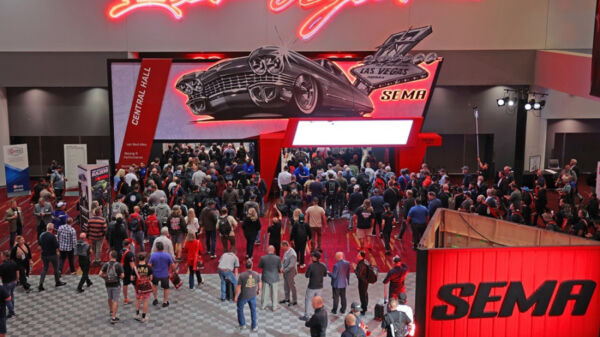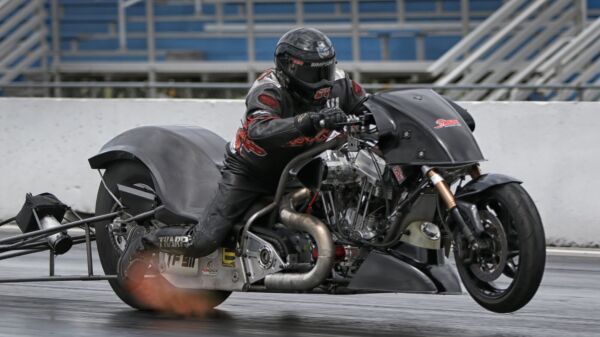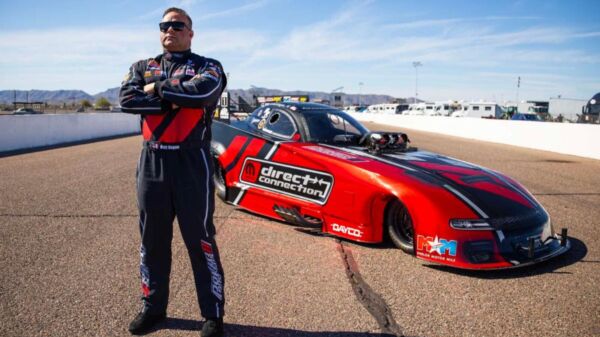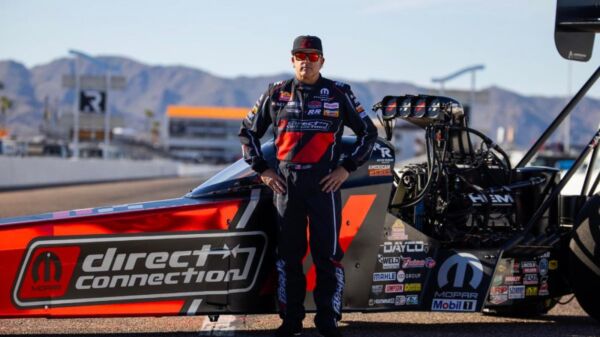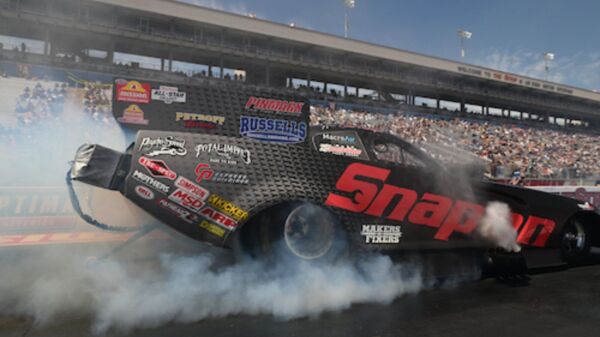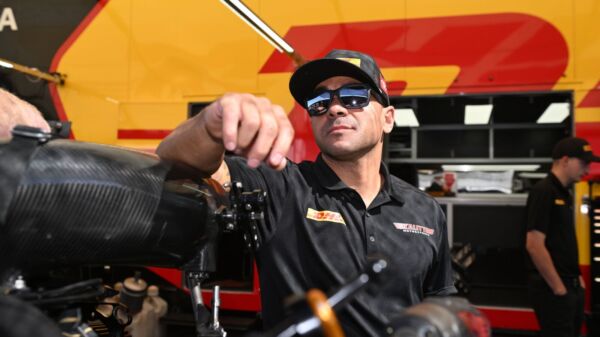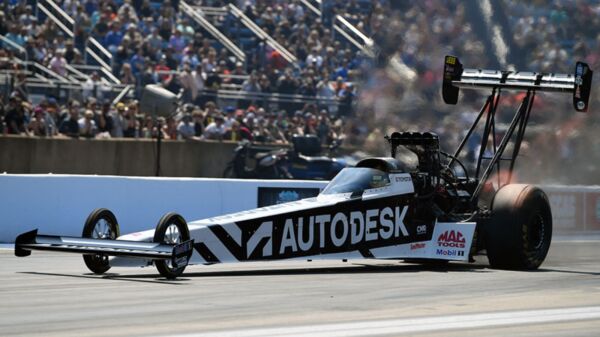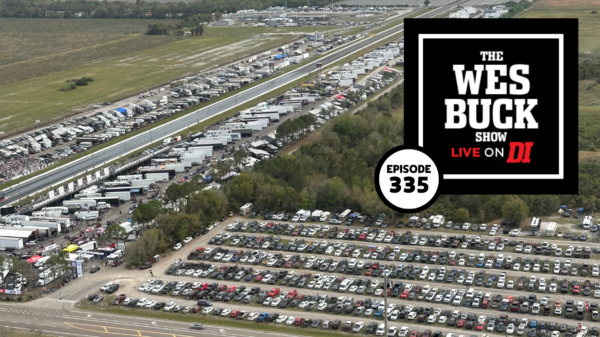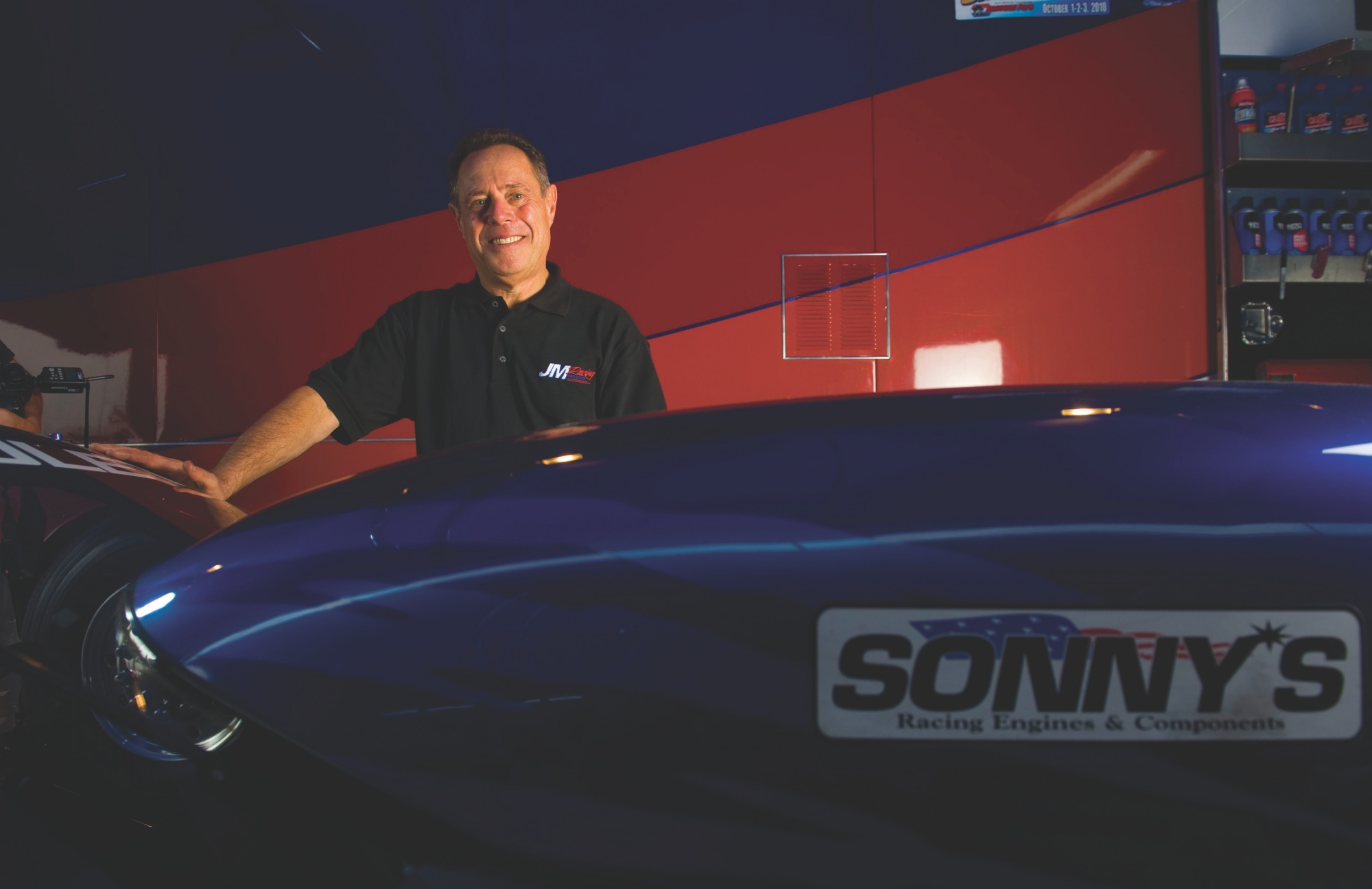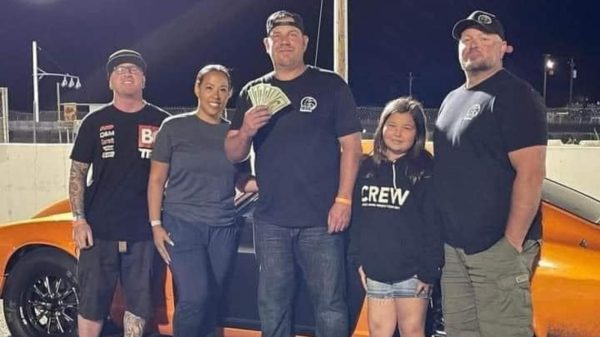John Montecalvo is a world champion, a driver whose prowess behind the wheel and on-track performance has earned him, after over a decade of trying, the right to wear the No. 1 on his car’s window. The writer who sits down at some point in the future to pen Montecalvo’s legacy following his retirement will be obligated to include one specific distinction to who he is – the thing that is both satisfying and heartbreaking to him, personally – and that’s the last IHRA Pro Stock world champion.
[Editor’s Note: This story originally appeared in DI #53 in May of 2011.]
The sport of drag racing has plenty of champions like Montecalvo. But in sixty years of organized competition, there have been a limited number of champions that have gone down in history as the last one their class ever knew. In sports as a whole, it would be hard to comprehend the magnitude to which the final World Series or Super Bowl champion would be celebrated, revered and preserved. To own that piece of history would be virtually unfathomable, but at 4:23 p.m. on Sunday, October 25th, 2009, Montecalvo laid claim to it – at least in the scope of drag racing.
Having gone into the final race of the ’09 International Hot Rod Association Nitro Jam Drag Racing Series season with the points lead, there was only a minimal chance for an upset, but Frank Gugliotta – one of the most game drivers in the business – still had a chance to steal it from Montecalvo in Rockingham, North Carolina. When Montecalvo’s mount failed him in the second round of eliminations, the door was left wide-open for Gugliotta, but it wasn’t meant to be. When the win-light illuminated in the left lane at The Rock, Gugliotta’s day was done, and Montecalvo had earned his first-ever world championship.
Despite having not won a race the entire season, Montecalvo’s consistency and perennial late round finishes propelled him to the title, and as sweet as it was for the Long Island, New York native that Sunday afternoon, it would take months for him to truly appreciate the scenario.
The reasons aren’t hard to imagine. In the eyes of most drag racers, Pro Stock and its power adder-equipped brother, Pro Modified, were the bread-and-butter of the IHRA. These were the two eliminators that made the sanctioning body unique from competing organizations like the NHRA, and at least for a while, the original American Hot Rod Association. Since “mountain motor” Pro Stock was introduced in 1977, it’s become an integral part of the drag racing landscape and created a tremendous following of purist fans – more knowledgeable and appreciative of the trade than that of any other category.
When the IHRA management team of Aaron Polburn and Scooter Peaco and the company’s new ownership, Feld Entertainment – which had made its name promoting three-ring circuses and choreographed motorsports events like Monster Jam – announced that Pro Stock, as well as Pro Modified, would no longer be contested on a regular basis by way of a press release on October 19th, 2009, it sent shockwaves throughout the sport. The underlying dynamic for the change was to create an entertainment-based motorsports program packaged into a three to four hour window, coupled with a minimally priced ticket, and ultimately expand the IHRA’s audience by attracting more casual fans.

Again, not hard to believe, was that these classes, Pro Stock and Pro Modified, were originally created to minimize confusion and grow mass appeal. Pro Modified was nothing more than a heads-up version of the IHRA’s long-running bracket category, Top Sportsman, and Pro Stock essentially a no-holds-barred version of the NHRA’s class, which at the time was laden with rules and a complicated pounds-per-cubic inch format. In 1976, Ted Jones, serving as the Vice President of Competition for the fledgling organization, brought to then-President Larry Carrier an idea that, at the time, could have been viewed as unthinkable as doing away with the categories is today.
“I told him [Carrier] that we needed to come out with a new version of Pro Stock and call it ‘run whatcha brung’,” said Jones, who now owns a television production company, in a 2007 interview. “No cubic inch limits – bolt the biggest damn motor you can in the car and bring it on. Make them weigh 2,350 pounds, run pump gas and have two four-barrel carburetors. We don’t even need to know how big the motors are. We’ll just tell them to put the big motors in there and come on out and race.”
Carrier’s response was equally detail-oriented. “Make it happen.”
Some thirty-three years later, it would appear wiping the historic mountain motor Pro Stock division out of the IHRA took a similar amount of thought. A class that had enjoyed the participation of drivers like Rickie Smith, Warren Johnson, Roy Hill, Ronnie Sox and countless others – many of which have become legendary figures in the sport’s history – had been relegated to an option on a class menu offered to track operators looking to stage a “Nitro Jam”.
The reaction of racers and fans when they suddenly realized their precious racing heritage was being stripped from them wasn’t an eruption of anger, but more a death-in-the-family level mourning.
“It was like somebody put a knife in my heart,” says John Montecalvo, speaking on the feeling of IHRA Pro Stock’s untimely demise in 2009. “We were all very loyal to the IHRA, we racers. We did whatever they wanted us to do. If they wanted us to display or do an appearance, whatever they wanted – we did it. Any interview you ever heard with a racer was all about how great IHRA was. To me, IHRA basically abandoned their roots, and I think we all took it very personally. We were all very hurt by it.”
The irony is no segment of drag racing – none – have shown more growth and fan interest in recent history than that of fast doorslammer racing. The IHRA’s most striking achievement was introducing to the world these ultra-fast, left-hand-steer, swinging-door-having race cars – recognizable and relatable to fans – and now, in an effort to improve their show, they were cutting them from the roster. It’s hard to imagine more backwards logic being applied at any point in drag racing history, especially when the IHRA had recently been leapfrogged by the American Drag Racing League, which contests these cars exclusively, as the clear number-two behind the NHRA.
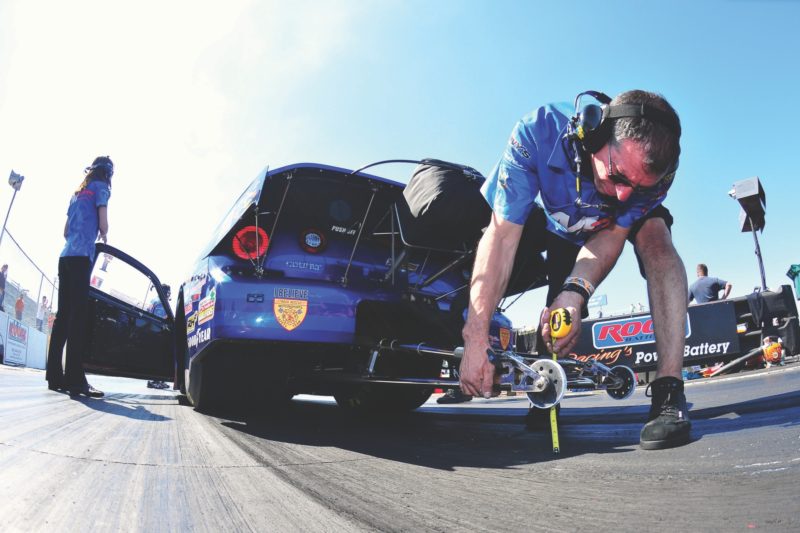
From the very start, Montecalvo’s racing career has been a moving tribute to the hopelessly optimistic nature and never-say-die attitude of a champion in the making. He got his start in Pro Stock in the early Nineties after seeing his biggest competitors on the local level – namely John Nobile and John Pluchino at his hometown stomping ground of Long Island Dragway – graduate from bracket racing and high-stakes match races to IHRA Pro Stock.
“I guess what convinced me to pursue Pro Stock was seeing John [Nobile] go over,” says Montecalvo. “I had a long conversation with Scott Shafiroff about what made the most sense for me to take it to the next level in racing. Of course, Scott was big on the Island, as he still is, and he was doing a lot of my engine stuff for me. I was thinking about NHRA Competition Eliminator, but Scott suggested IHRA Pro Stock – and with John already there, it actually made it an easy decision for me because I wanted to race on a pro level, and I wanted to race for a championship.”
Unable to dedicate his full attention to racing as he operated the family business – John T. Montecalvo, Incorporated, an asphalt manufacturing company started alongside his brother and father – Montecalvo started off going to a handful of events each season before ultimately committing to the full IHRA tour.
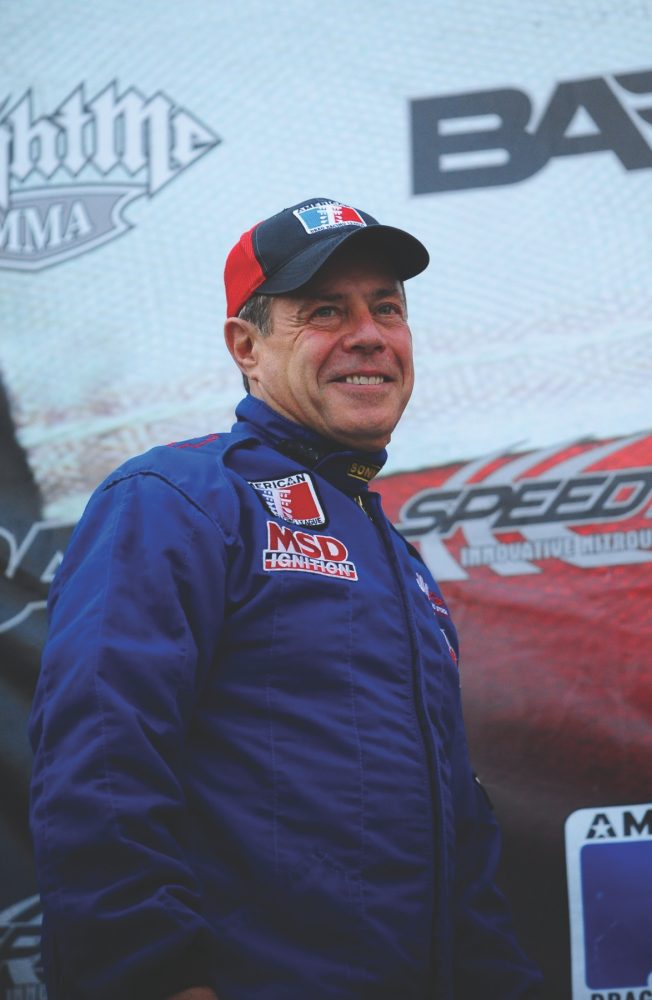 “I remember those days,” says Montecalvo. “It was a lot of fun. Bristol, Darlington, Budds Creek – it was incredible back then. The stands were packed at all the races and there was sort of a core of tracks that the IHRA just really had a tremendous following at. Sometimes I wonder if that was IHRA’s mistake, venturing out from those core tracks. I was driving a dually, literally, 25 hours out to Nebraska.”
“I remember those days,” says Montecalvo. “It was a lot of fun. Bristol, Darlington, Budds Creek – it was incredible back then. The stands were packed at all the races and there was sort of a core of tracks that the IHRA just really had a tremendous following at. Sometimes I wonder if that was IHRA’s mistake, venturing out from those core tracks. I was driving a dually, literally, 25 hours out to Nebraska.”
By the late Nineties, Montecalvo was committed, a regular in the Pro Stock pits, and scored his first national event victory in September of 1999 when he qualified number-one and took out Ron Miller in the final at the Parts Pro North American Nationals at New England Dragway.
“That was a big deal,” remarks Montecalvo, who scored the only win of the year for Chevrolet. “I don’t know how many years; it was one thing or another. Sometimes it was the driver, sometimes the car, and sometimes a combination of both. There were times when the Fords, they’d just outrun us – we certainly were two- or three-hundredths behind them for what seemed like forever. They dominated back then.”
When he had guys like Gene Wilson in his Ford Thunderbird literally driving away from him, Montecalvo leaned on his engine builder, Sonny Leonard.
“I have to say, I think every time I ran Gene, I believe I left on him,” insists Montecalvo. “Well, probably 90-percent of the time, anyway. But by the time I was in third gear, Gene was in high gear. You were just running for second place.
“It was extremely frustrating,” he continues. “When you don’t have the power to run with them – you’re doing a good job driving the car, the crew’s doing a great job, but by third gear the race is over – it was very frustrating. The only satisfaction came from winning on a holeshot, but that’s a difficult position to be in. In some ways you feel like you have nothing to lose and your competitor had everything to lose, but it’s still a tough position.”
Facing the reality that he would either have to get a Ford or find a way to enjoy losing, Montecalvo, at the suggestion of Leonard, approached the IHRA technical department with a plan of action that would bring parity amongst the various automobile manufacturers.
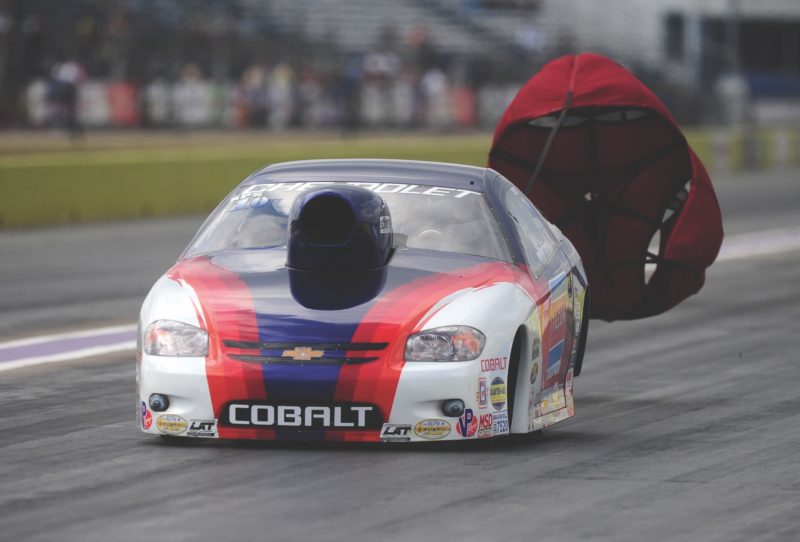 “I kept hearing from Sonny that if we had a Hemi-head we could run with these guys,” recalls Montecalvo. “I kept asking, ‘Well, why don’t we?’ Basically, he didn’t think IHRA would ever approve one. So, being a Chevy man, and seeing the class headed to a point where we’d have to run all Fords, I called a meeting. It was Sonny, John Kaase, Calvin Nabors, Tim’s dad who was building motors back then, Mike Baker, the technical director of the IHRA, and myself. I just said, ‘What are we going to do here?’”
“I kept hearing from Sonny that if we had a Hemi-head we could run with these guys,” recalls Montecalvo. “I kept asking, ‘Well, why don’t we?’ Basically, he didn’t think IHRA would ever approve one. So, being a Chevy man, and seeing the class headed to a point where we’d have to run all Fords, I called a meeting. It was Sonny, John Kaase, Calvin Nabors, Tim’s dad who was building motors back then, Mike Baker, the technical director of the IHRA, and myself. I just said, ‘What are we going to do here?’”
As the unlimited version of NHRA’s factory hot rod class, it was imperative to the success of the category that diversity remained feasible amongst competitors.
“We felt that as far as the fans are concerned, the best show would be Ford versus Chevy versus Dodge,” he says. “We wanted all the brands out there, and Baker agreed with us. From there, it took all of 10 minutes for him to approve it. Kaase was on board because he understood the dynamics of it, and it would be something unique to the IHRA as there wasn’t such competition between the various brands in the NHRA. Sonny went to work with a thought in his head and submitted everything to Baker for his approval, and in 2002 we had the first Hemi-headed Chevy engine.”
Easily frustrated when logic isn’t applied, Montecalvo has never been one to sit by idly while a problem exists and let whatever happens happen.
“I get frustrated when something makes a lot of common sense, but you can’t get the point across to people,” says Montecalvo. “Maybe it’s about having a little vision or foresight, which I think sometimes the powers that be in these organizations don’t always have. I was so happy Mike Baker agreed with us. We needed that competition – it’s what Pro Stock is about, and always has been. Win on Sunday, sell on Monday.”
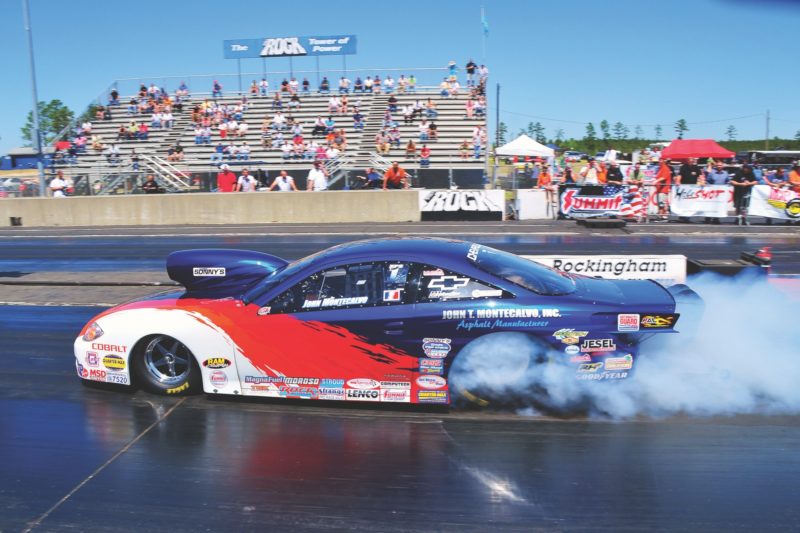
Look back over the recent history of mountain motor Pro Stock and you will find what appears to be a tight knit group of friends, first and foremost, and competitors second. The Pro Stock brethren have shown impressive unity, but operating as a unit hasn’t always been well received.
After a number of Pro Stock racers agreed as a group not to attend the IHRA national meet in Edmonton, Alberta, Canada over the Fourth of July weekend in 2008 due to the travel costs associated with the event’s location – despite advanced warning – IHRA President Aaron Polburn famously told a North Carolina newspaper, “if this would even come close to happening again, I can tell you that class can put their cars up on eBay because they would never, ever come to one of our tracks again.”
Montecalvo’s level-headedness and willingness to think of and act on what is best for his class and fellow competitors has earned him tremendous respect amongst his peers, and though he agrees Polburn’s comments were likely made in haste, can’t help but feel they marked the beginning of the end.
“That was a very difficult time for us,” says Montecalvo. “If I recall, fuel was up to almost five-dollars-a-gallon and for us to go to Edmonton just didn’t make sense. We didn’t ask for a lot, just a little bit of help with fuel. Me, personally, I never shut the door. I felt like the door got shut on us at that time. I’ve got to say, I still consider Aaron [Polburn] and Scooter [Peaco] friends. We still talk occasionally, but I guess we pretty much got the feeling that we weren’t wanted. It only made it more difficult that we felt like we were a part of a family, so when this happened – it felt like a family going through a divorce.”
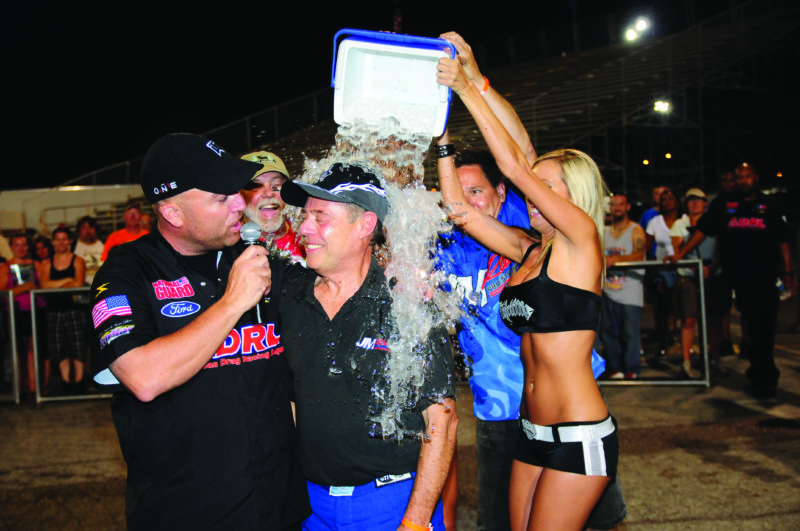 Then, in the middle of this standoff between IHRA Pro Stock racers and Polburn, the ADRL made it known that they intended to contest their own version of the class on the eighth-mile the next season. When the ADRL released their schedule at the 2009 Performance Racing Industry Trade Show in Orlando, Florida, there were two dates that likely leapt off the page at IHRA officials – the ones that directly conflicted with their own shows in Shreveport, Louisiana and Epping, New Hampshire. Montecalvo, after making phone call after phone call trying to get either organization’s schedule amended so that racers could support both series with no luck, put together a plan to simply go to both.
Then, in the middle of this standoff between IHRA Pro Stock racers and Polburn, the ADRL made it known that they intended to contest their own version of the class on the eighth-mile the next season. When the ADRL released their schedule at the 2009 Performance Racing Industry Trade Show in Orlando, Florida, there were two dates that likely leapt off the page at IHRA officials – the ones that directly conflicted with their own shows in Shreveport, Louisiana and Epping, New Hampshire. Montecalvo, after making phone call after phone call trying to get either organization’s schedule amended so that racers could support both series with no luck, put together a plan to simply go to both.
“When I saw the IHRA and ADRL had scheduled their events on the same weekend, and that both sides were unwilling to change their schedule, I was disappointed,” says Montecalvo. “I wanted to race against all the best, not half. Seeing that the tracks were only 270 miles apart, about five hours in our race rig, I talked with the team and we felt it was possible to go run them both. The plan was to qualify for the IHRA event on Friday, pack up and head to Houston for the ADRL event where one round of qualifying and eliminations were held on Saturday, then head back to Louisiana on Sunday to finish with the IHRA.”
But the epic two-in-one weekend met its match when an air line broke on the shifter, causing Montecalvo to abort his qualifying run after the engine briefly touched the high-side rev limiter. Needing to swap engines, Montecalvo and company made the decision to stay put in Shreveport and miss the first ADRL event of the ’09 season. Though the significance of his decision to run the IHRA season opener wasn’t known at the time, eight months later when Montecalvo was being crowned the Pro Stock world champion it was very apparent.
Unfortunately, there would be no engine builder or racer summit that could resolve the next dilemma facing mountain motor Pro Stock racers; that of being dismissed by the IHRA. For Montecalvo, who had battled it out with some of the best drag racers the sport has ever known for years, it was bittersweet to finally earn the coveted IHRA Pro Stock world championship, but be unable to defend the title.
“I can’t even describe what it feels like,” says Montecalvo. “If I would’ve known then what I know now, that we could very possibly be the last IHRA Pro Stock world champion… That really started to set in last year; I started thinking about that. I don’t know if IHRA Pro Stock is ever going to come back, and if it does I don’t know what form it will be in. I’m not shutting that door, though.”
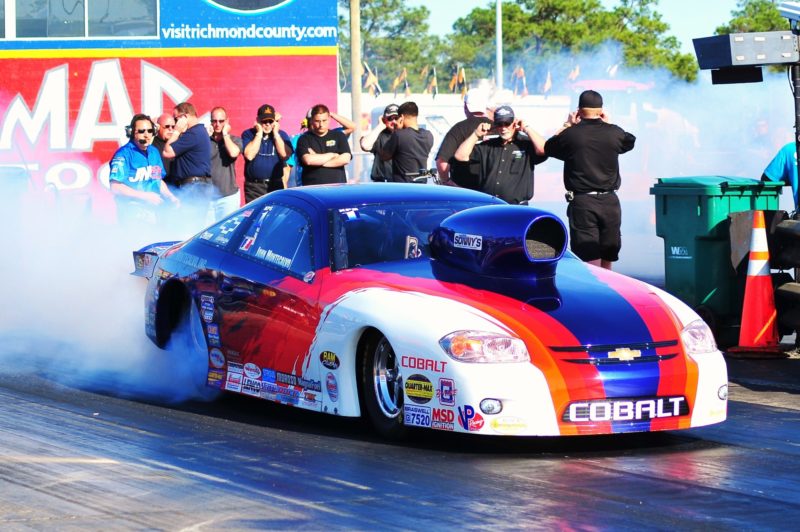
Although there has been a new home created for mountain motor Pro Stock racers in the American Drag Racing League, the budding eighth-mile series doesn’t exactly replace what existed within the IHRA. At the urging of a handful of racers, former ADRL President and CEO, Kenny Nowling, held an exhibition at Dragstock III in 2006, and by the time the IHRA was working behind the scenes to eradicate doorslammers from its pro-show, the ADRL had already put together a 10-race series for its Extreme Pro Stock division with a championship points fund.
These dyed-in-the-wool mountain motor stalwarts weren’t going to let racing on the quarter-mile become a thing of a past, though, and continued to take the bull by the horns, establishing the Mountain Motor Pro Stock Association – which held five events in 2010 and was a success by all accounts. The workload attached to operating a race promotion, however, proved to be hard to bear for the racers competing within, especially those with thriving commercial businesses they must operate on a day-to-day basis. Though garnering a lot of headlines last year, the Mountain Motor Pro Stock Association has been quiet through the winter months.
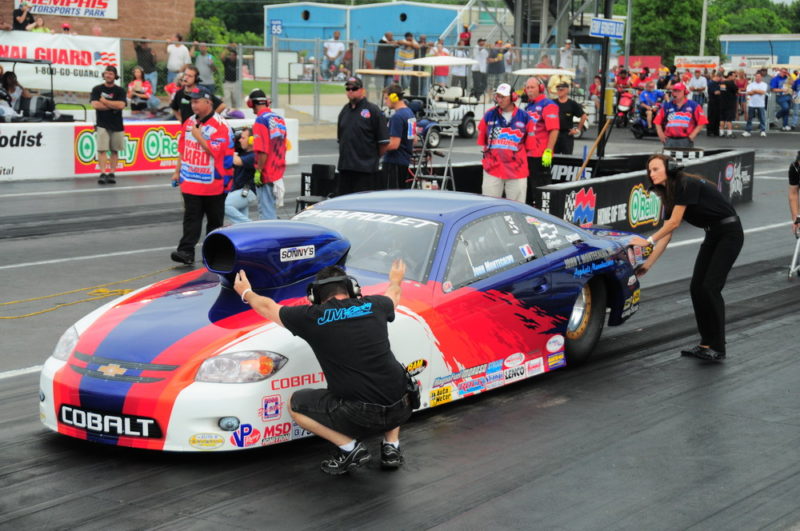 “At this point, I’d say it’s just on hold,” says Montecalvo. “All the responsibility fell on Pete Berner’s shoulders, and I think it’s just too much for one person to do. Pete’s got a business, he’s got a family life, and he’s also got a very serious racing program going with his own engine-building shop and all that. I think his focus is going to be getting his program where it needs to be, and not necessarily trying to run an organization.
“At this point, I’d say it’s just on hold,” says Montecalvo. “All the responsibility fell on Pete Berner’s shoulders, and I think it’s just too much for one person to do. Pete’s got a business, he’s got a family life, and he’s also got a very serious racing program going with his own engine-building shop and all that. I think his focus is going to be getting his program where it needs to be, and not necessarily trying to run an organization.
“Quite frankly, we’re racers. We’re not made to run organizations. We just want to race our cars. I think the concept is good and it was very successful last year as far as the actual races go, but nobody else really stepped up to the plate to help Pete. We’re all at fault. I think he did a great job and I think our organization proved that we could take the fate of our big-inch fraternity into our own hands, and keep this type of racing alive. So, it might be on hold, but I can’t say forever.”
For now, Montecalvo is content with the ADRL as his drag racing home. Denied the opportunity to adorn his single-digit badge of honor and defend the throne as champion of the IHRA, he took the mantra to Extreme Pro Stock and captured another first-ever championship during the ADRL Battle for the Belts this past October.
“I had established a goal many years ago of winning an IHRA championship,” says Montecalvo. “When we won that championship in 2009, with everything going on, I was so happy, and I didn’t think that feeling could ever be topped. Winning that ADRL championship belt, winning when it mattered, amidst the energy created by the Battle for the Belts – it topped it.
“The ADRL picking up the mountain motor Pro Stock cars came about at just the right time,” he continues. “I love racing in front of the crowds they have, and just seeing the kids and the families come out to the races. We haven’t seen that as much in years past because of the expense associated and the economy, but to see these kids wide-eyed, it’s exciting. We also see a lot of fans that got to know some of us and the mountain motor cars from the IHRA, and that’s validating. But it’s nice to be in a place where you’re wanted and you feel like you’re part of something.”
So, regardless of the fact that for better than 30 years, big-inch Pro Stockers were synonymous with the IHRA, Montecalvo and nearly two dozen close friends, who are the drivers of the meanest naturally-aspirated race cars on Earth, have been adopted by a sanctioning body that appears to respect them and appreciate their contribution to the show. Though the same speed-induced thrill may not exist in a shorter racing distance, the close competition and increased safety, in Montecalvo’s opinion, far outweigh any negative.
“I’m happy where I am,” he says. “At the time, back in the day with Ted Jones and everybody, the IHRA had established itself as a very close competitor to the NHRA, and it was a good alternative for people who didn’t want to run a full 22 or 23-race tour, or couldn’t afford it. I know that’s what appealed to me about IHRA Pro Stock in the beginning. The ADRL is clearly that now. I’m at a point where I’m just not going to run 16 or 17 events a year. We did that for two years, running all the IHRA and a few ADRL events, but it was very hectic.
“Beyond the logistics, the eighth-mile format is definitely safer, and that’s priority number-one with me. A lot of things happen in that last half of the track and I don’t know if I want to be going 230 miles per hour anymore. I’m happy with 180. Do I miss putting it in high gear and running it out the back? I do. There’s nothing like putting a big-motored car in high gear and just riding, letting it pull all the way down the track. I never ran a 500-inch car, but I would imagine it’s quite boring compared to what we do.”
Races being decided by a few hundredths-of-a-second is nothing new to Pro Stock, but having half the distance in which to score a win has only brought the cars closer together, and Montecalvo believes it has also opened the door up to some lesser-funded teams.
“I’ve always been for the low funded teams and trying to keep the costs down in drag racing,” says Montecalvo. “The eighth-mile keeps the cars close, and while horsepower is always going to be king in Pro Stock, it evens things up and makes the starting line even more important.”
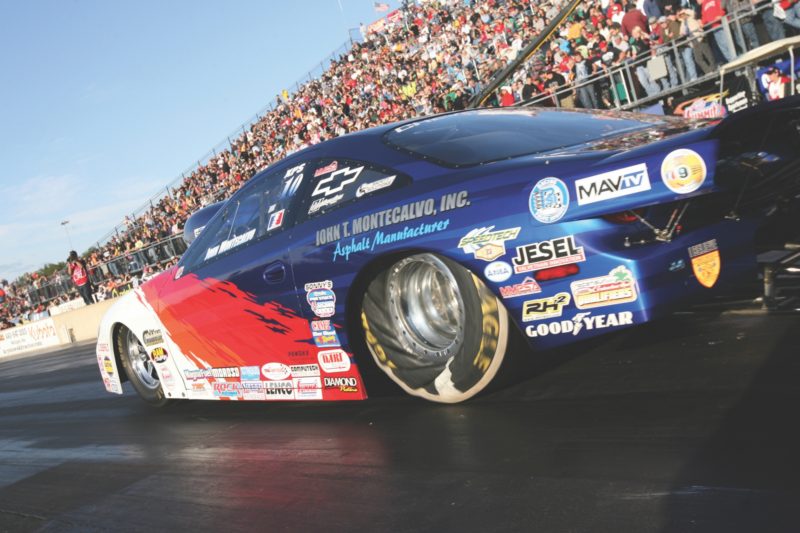
Montecalvo’s irrepressible resolve is a serious problem for his competitors, propelling him to two championships in consecutive years in two different sanctioning bodies, but also motivating and inspiring for those around him, especially when looking at what the future holds for mountain motor Pro Stock. Now a part of an organization that is experiencing growth and forward movement, Montecalvo and the big-inch boys can rest a little easier that they are on solid ground and won’t be looking for a new place to race or listing their cars on eBay in the near future.
They say change is the only constant, especially true in the ever-evolving world of drag racing, and organization and preparation may be the only effective way to deal with whatever comes next. When the IHRA left Pro Stock out in the cold, it was the racers who took matters into their own hands – forming an association, and prior to that lobbying for the addition of a Pro Stock eliminator to the ADRL. Moving forward, it’s important that racers in all categories, especially touring professionals, realize that united they stand, divided they fall.
“It’s always good to have an organization,” says Montecalvo. “It’s debatable how strong PRO [Professional Racers Organization] is over in the NHRA, but the theory is sound. A couple representatives from each class that can stand up for the drivers, but also not be overly confrontational. For Extreme Pro Stock, I would want it to be something that worked in conjunction with the ADRL, not against the ADRL. I think that’s where you run into problems. It’s a fine line.”
Defined by a clear and precise set of rules, mountain motor cars, currently contested exclusively in the ADRL’s Extreme Pro Stock division, are the only cars in the organization that mandate a minimum weight and maximum engine size. Montecalvo feels those rules are critical to the long-term success of the ADRL’s brand of Pro Stock, though he’s open to most anything that would build on the category’s appeal.
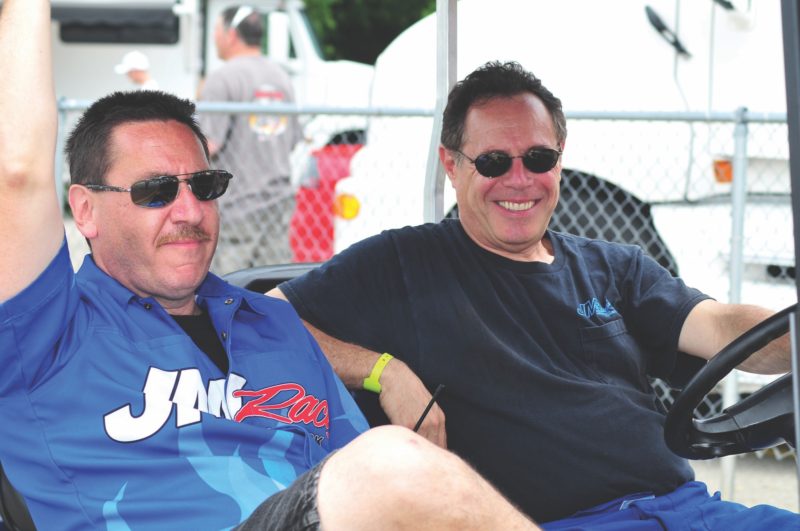
Montecalvo (right) with longtime crewman William Cavallo
“I’ve always felt Pro Stock is more of purist class,” says Montecalvo. “You have to be knowledgeable, but I think our biggest asset has always been very close racing. What distinguishes us the most is that we’re not ’63 Corvettes with blowers sticking through the hoods – we race cars that do, at least somewhat, look like factory cars.”
Having fought the good fight in the past to ensure more than one automaker was being represented in his class, Montecalvo believes more should be done to bring Detroit’s current lineup of muscle cars to Extreme Pro Stock.
“I think there are a lot of people that relate with what we do,” he says, “but I think they’d relate even more so if we had Mustangs, Camaros and Challengers out here. Cars that are really recognizable, have an identity in racing, and that you could go out and drive off the showroom floor today.
“With this deal, you have to stay open minded,” Montecalvo admits. “I’ve got mixed emotions on things like electronic fuel injection, as I don’t know how it can be policed. But I’m sure once NASCAR gets involved, and they are, that the drag racers will follow. Of course, you have to change with the times and if the majority thinks that fuel injection, flat hoods or whatever else is the change we need – even though I’m not convinced – I’m all for it.”
If nothing else, Montecalvo longs for the continuation of the tradition that has become mountain motor Pro Stock racing. As the last champion IHRA Pro Stock will likely ever crown, he has permanently etched his name in the sport’s history books, but don’t look for him to dwell on what could have been. He’ll have his hands full behind the wheel of his 822 cubic inch mountain motor-powered Chevrolet Pro Stocker, and most assuredly no time to look back.
Photographs by Mark J. Rebilas, Bubba Smoothe, Van Abernethy and Roger Richards
This story was originally published on March 18, 2020. 
